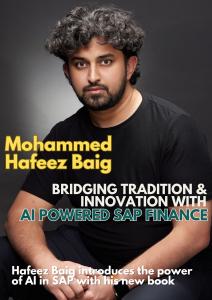Generative AI Finds a Strategic Foothold in Enterprise Finance: A New Book Charts the Path for SAP Integration
A practical roadmap for integrating Generative AI into SAP Finance—bridging structure with intelligent innovation.
NEW DELHI, INDIA, July 8, 2025 /EINPresswire.com/ -- As generative AI moves beyond early experimentation into core enterprise functions, a new book titled AI-Powered SAP Finance is capturing attention across digital transformation circles. The book, authored by SAP finance expert Hafeez Baig, offers a structured, scenario-based approach to integrating AI with one of the world’s most widely used enterprise systems—SAP.The timing of the publication is significant. With organizations under pressure to modernize financial operations while maintaining compliance, audit integrity, and operational efficiency, SAP users are looking for ways to go beyond automation toward intelligent orchestration. This book seeks to provide a blueprint for doing just that—merging traditional ERP frameworks with the adaptive potential of generative AI.
Moving Beyond Automation: AI as a Decision-Making Partner - SAP S/4HANA, SAP’s flagship ERP platform, has already made strides in embedding machine learning and analytics into financial workflows. Predictive cash flow forecasting, intelligent invoice matching, and rule-based approvals are now standard features in many implementations. However, Baig’s book takes this a step further—by introducing Generative AI models into the mix. These models, such as large language models (LLMs), can produce synthetic data sets, summarize complex reporting structures, generate financial narratives, or even support the design of new workflows based on natural language prompts.
For example, imagine a finance controller needing to explain quarterly variances to leadership. Instead of sifting through SAP BW reports manually, a generative AI model integrated with SAP Analytics Cloud could automatically produce a contextual summary: outlining key drivers, trends, and recommended adjustments—all pulled from real-time system data.
These kinds of use cases are more than theoretical. In a recent pilot by a global manufacturing firm, integrating OpenAI’s GPT model with SAP FICO allowed their finance team to automate over 70% of recurring report commentary while reducing review cycles by 30%. The outcome: faster decisions and fewer hours spent interpreting static dashboards.
A Practical Framework for AI Integration :What makes AI-Powered SAP Finance notable is its structure. Instead of offering a generic overview of AI, it walks readers through actual SAP finance scenarios—such as month-end close, vendor reconciliation, tax provisioning, and audit preparation—and explores where and how AI capabilities can be embedded.
The book identifies five core areas where generative AI can impact SAP finance operations:
1. Narrative Financial Reporting – Using LLMs to generate contextual executive summaries.
2. Data Cleansing and Classification – Automating master data enrichment using AI-based pattern recognition.
3. Audit Readiness – Creating simulated audit trails or control narratives for compliance documentation.
4. Training and Change Enablement – Generating SAP training guides in real time, based on custom workflows.
5. Decision Support – Enabling finance teams to query live financial data in natural language.
These examples are tied directly to SAP modules such as FICO, MM, and SAC, making the book particularly valuable for practitioners seeking implementation relevance rather than abstract theory.
Context in a Rapidly Shifting Industry
The release of the book also aligns with larger movements in the enterprise software space. SAP itself has doubled down on AI, announcing in 2024 its partnership with major LLM providers to deliver “AI Co-Pilots” across its suite. Meanwhile, clients across industries—from retail to logistics—are experimenting with embedding generative AI for everything from finance to HR operations.
According to IDC, by 2026, over 60% of SAP-enabled enterprises will use some form of generative AI in their finance function. Yet, as many experts note, the gap between “tool awareness” and “practical implementation” remains large.
“There’s no shortage of AI vendors—but the challenge lies in integrating those capabilities with structured systems like SAP without disrupting business continuity,” said Alisha Mehta, Principal Consultant at FinTech Edge. “That’s where resources like this book become relevant—they connect ambition with operational clarity.”
In regions like India and the UAE, where digital transformation is rapidly accelerating, SAP remains a foundational system across finance, public sector, energy, and manufacturing sectors. This book arrives as organizations in these markets explore ways to leapfrog from automation to true AI-driven finance.”
Enabling the Workforce, Not Replacing It
Importantly, AI-Powered SAP Finance underscores a human-centric approach. Rather than presenting AI as a replacement for financial roles, it promotes upskilling and augmentation. By providing templates, prompts, and decision trees, the book empowers SAP consultants, analysts, and controllers to work with AI—building hybrid workflows that combine system logic with generative intelligence.
The book also touches on the ethics of enterprise AI—advocating for transparent data use, audit-ready AI interventions, and equitable access to transformation tools. These are increasingly critical themes as regulators and stakeholders scrutinize AI’s impact on governance and accountability in financial reporting.
A Reference for the Future-Ready Finance Team: While the market continues to flood with AI tools, few resources currently address how generative AI can be practically embedded into the structured environment of SAP ERP. AI-Powered SAP Finance aims to fill that gap—not as a theoretical thesis, but as a field manual for transformation leaders.
Its value lies in what it delivers: clarity amid complexity, structure amid disruption, and a practical language for navigating the future of enterprise finance.
For organizations seeking to modernize without compromise, and for professionals eager to stay ahead of the curve, this book offers a timely and much-needed guide.
USA NEWS
Neuworldz LLC
support@neuworldz.com
Visit us on social media:
LinkedIn
Instagram
Legal Disclaimer:
EIN Presswire provides this news content "as is" without warranty of any kind. We do not accept any responsibility or liability for the accuracy, content, images, videos, licenses, completeness, legality, or reliability of the information contained in this article. If you have any complaints or copyright issues related to this article, kindly contact the author above.

